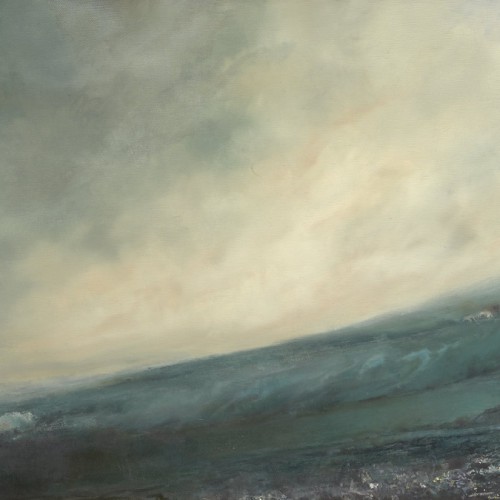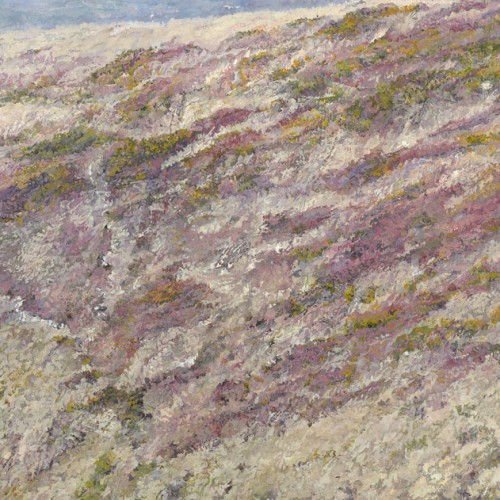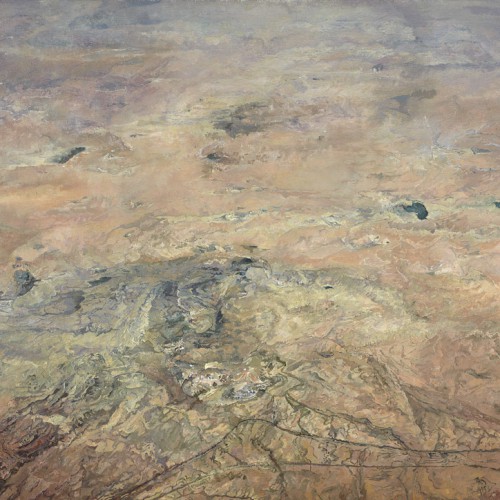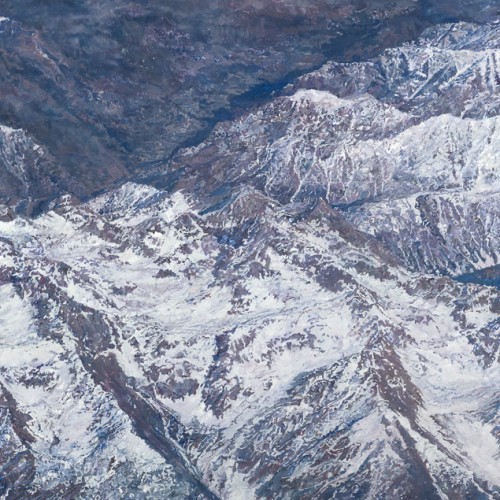An interview with Thérèse Oulton recorded in February 2010.
- Untitled no. 7, 2008
- Untitled no. 11, 2008
- Untitled no. 10, 2008
- Untitled no.23, 2009
First of all I really enjoyed your new paintings in ‘Territory‘, exhibited at the Marlborough Gallery, which seemed a very coherent body of work. They seemed to capture a mood of change and reinvention and a change of identity, can you talk me through that?
In order to talk about what’s there in the gallery I would have to look back to what I’m calling in my head ‘a crisis of relevance’, a period that spans the last three years painting ‘Territory’, probably going way back. This was not a crisis in the studio. That internal dialogue, myself, the work and in that sense a self-sufficiency, could have carried on. But it was too hermetic and the real dialogue of painting is in the end with the world. It has to be part of a wider discourse.
The response to shows previous to this was less than I used to get; they were really vivid at one time. What I saw as their clarity seemed to be obscurity. Even the title of the last show, ‘Lines of Flight’ now seems prescient of a crisis. So I took time to rethink everything. I even thought of totally changing direction.
You mean stopping painting for a while?
I was trying to imagine myself minus painting. But my stopping was laughed at. I’m a lost person without painting.
Do you think you were trying to find a new you, or a new phase of work?
I even question the notion of a ‘You’. I always have. And I think you construct a ‘You’. My ‘You’ was a body of work of some twenty-five years. That is become me. The question was; are you anything if you extract that from the equation. Erase what you were, see if there’s anything left. Instead of giving up painting I decided on a completely different strategy. You said the show looked coherent to you; it actually consists of lots of hesitations, small moves backwards, forwards, of rejections.
Did you discuss this with other people, who follow your work?
I did, but it was more of a private struggle. I had a little studio in a domestic building and had become rather isolated.
It easily happens.
In fact, I wasn’t in a position really to judge any reverberations, any influence of the work. In the catalogue notes introducing ‘Territory’, I talk about walking. That’s when I do a lot of thinking. But I do miss discourse with other artists.
Your studio is now empty, with the show on; where are your paintings from the past? Do you keep them at home or in store?
Some are stored, but I produce pretty slowly. The first year of this change, I was roaming around, pain ting in various spaces and then I found this studio a year and a half ago. So I started afresh and those works are all in the exhibition.
The works in Territory are all untitled, and because of that it leads one into a maze of finding clues to where the subjects might be. These landscapes are like dreams, but hang onto somewhere. Is it tied to your walking?
Walking is a linear way of covering distance in landscape; the paintings anything but that. Walking is very close to my heart. Perhaps a particular place would be if I lived in the country. But London is where I’m based and London does what the paintings do; it dislocates one. I can’t conceive of London as my home, I see it as an extraordinary conglomeration of incoherent spaces.
I think you’re quite right, London is villages strung together, each has its own identity.
It’s so extraordinary, the montage of differences that is London. It’s difficult for me as a Londoner to think of it as home though my feelings for it go deep. None of the landscapes is of London though I did attempt and failed to get an image of it. To answer your question though, the clue as to their subject is in the not being able to place.
What about the intervention of photography with painting, the way the camera tries to make decisions for you.
The photograph in itself has already gathered enough complexities to not be what it was once assumed to be; a neutral mirror of some truth. Photography has got its own, now ageing history as well. But it’s photography’s refusal to select, its accumulation of excessive detail that I’m taking into account here. Though the photographer selects the image, that image comes along with excess baggage and it’s that ‘overlooked’ that I want to paint, the material that gets overlooked as the eye looks for the subject. Not only in the detail.
Also in the selection of the image that may be bits we would rather not acknowledge, what we’ve done to the earth, areas of unreconstructed, abandoned heavy industry, mining, the scars left on the earth’s surface. But not just that. The overlooked in the sense of the ordinary, the bits of land between other types of use. Photography, analogue, digital, whatever does complicate the viewing of these paintings.
I’m sensing some fairly profound changes have taken place for you with this new series. How did you find your way?
During the three year period of painting ‘Territory’, I had, I suppose, intuitions that would go in one direction then I would say, no that’s too literal, and another in which I would think, no, that’s too much towards Romanticism, that’s too sharp focused and so on. I tried to squeeze between possibilities and rejections – am still. It’s not a something I’ll find. The earlier ones perhaps bear witness to this thinking more overtly; more trace too of a consciousness of bringing Romanticism into the twenty first century. Not looking down from a mountain top, the view became higher, more remote.
There are elements in the paintings of Territory, in their composition; where in the lower third is the site, the industrial complex, the highways, bridges, all described minutely; and then you sweep the viewer away into the ether. Even in a small painting, it’s powerfully disorientating, like vertigo.
Yes, very much like vertigo, and this links back to what I was saying about the sense of self. That is if you take away all the props that you imagine are your reality, family, home, profession, most of all perhaps as a body your sense of geography, the sensation of what’s left could be vertiginous, how you orientate self in a landscape and the loss of that. So the loss of self or as you say the disorientation, and the loss of the beloved patch of land with which you identity are very much part of these landscapes.
Caspar David Friedrich comes to mind.
Yes, often a Caspar David Friedrich refuses to give the viewers a firm foothold. The foreground disappears one has the sensation of being pitched down a ravine. You spoke of the ether; when we go up into our ether, in an aeroplane, it’s decidedly murky – pea green smog before you break through to cleaner air. The atmosphere of the 19th century would seem to us clarity in comparison to ours though Romanticism might be an aesthetic reaction to their own industrialisation, their own losses of familiar landscapes.
So our heritage is the ruined earth, at least there’s a lot of damage.
There is, but I wanted to really look at it all, not to romanticise it. There’s an apocryphal story when 19th century travellers went over the Alps they would close the coach blinds, because it was considered indecent to confront the savagery of nature.
Alpine peaks today are territorialized by the tourist industry, an odd result of Beauty versus sublime. I don’t want to overlook the reality of how the earth looks now – or one heads toward the picturesque. We have now specially delineated picturesques – national parks, nature reserves.
I know, I don’t want to have a sign on Dartmoor telling me, ‘View this Way’, those visitor destinations.
Absolutely.
Territory does have a sense of exhilaration, as a pointer to possibilities; to a new way of engaging with the landscape.
Yes. Redemptive is a rather weighty word to use but at least the attempt. But the overlooked. I don’t see why one thing should gain attention, be more important, another overlooked. Photography with its bland eye doesn’t see the difference between a fetid pool and a snowy mountain, a clear blue sky or purplish smog.
I get a feeling of your renewal, maybe the casting off of an old skin, but where does this leave you in relation to all you did before? The link isn’t broken with those works.
I thought it was, but I’ve had many responses that confirm a continuity. I could construct a lineage backwards but I don’t think that’s right. I think the earlier works have their own concerns. I was always called an abstract painter and have always refuted it, but I could never shift how I was categorised. The paintings were never abstract, they were always engaged with representation, the how of representation, the effect of that. Perhaps the term abstract is used as a defence mechanism to avoid the reality of a work.



